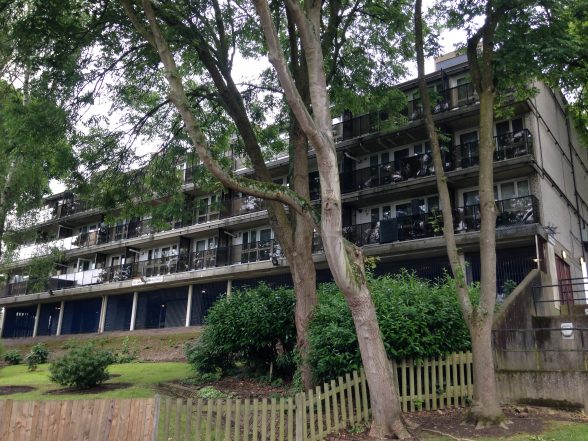This website uses cookies
This website uses cookies to enable it to function properly and to analyse how the website is used. Please click 'Close' to accept and continue using the website.



Photographed by Grace Etherington
The Twentieth Century Society is deeply disappointed that Historic England has turned down a second application to list the Central Hill Estate in Gypsy Hill, Lambeth. The Society wrote to support this second application, calling on Historic England to list the estate at Grade II. Historic England has rejected the application at validation stage, concluding that “We do not believe that the estate has evident significance”.
An application was made to list Central Hill in 2016 but this was unsuccessful. Historic England decided not to recommend the estate for listing, stating in its Advice Report that “Central Hill relies on the drama of its topography for much of its effect, rather than the virtuosity of its architecture, blocks are repetitious and lack the formal complexity and quality of detail which marks listed examples out as special […] the overall layout of the estate […] lacks sophistication and aesthetic variety [and] the estate reflects, rather than pioneers, ideas relating to the provision of mass housing which were evolving at this time.” It claimed that “Whilst Central Hill has many merits, it falls short of the very high bar for listing post-war housing estates.” See C20’s response at the time here.
In its recent response, Historic England said “As five years has passed since that decision, we have considered very carefully all of the points raised in a recent further application, to determine whether the estate should be reassessed for listing.” “We have concluded that the claims made about the architectural and historic interest of the estate were addressed in our 2016 advice, and no substantive new information that may be considered in a listing assessment has been presented so we will therefore not be taking this application further.” It added that “Should circumstances change in the future, we may reconsider this position.”
The C20 Society calls on Historic England to review its recommendation, arguing that Central Hill is clearly of evident significance and that appreciation for the estate and its architects has grown since 2016 and this should be taken into account. Central Hill is under serious threat of demolition and should be treated as a priority case.
Central Hill was built as a public housing estate in 1970-74 by Lambeth Borough Council. The estate was designed and constructed by the Lambeth Architects Department under Edward (Ted) Hollamby, Director of Development and former Borough Architect. The team leader was Rosemary Stjernstedt and the assistants were Brian Roberts, Frank de Marco, Adrian Sansom.
Hollamby was a significant figure in the development of post-war social housing. He moved to the London Borough of Lambeth in 1963, initially as Borough Architect and later as Director of Development. Over the following two decades, under Hollamby’s direction Lambeth acquired a national reputation for its public housing schemes. Stjernstedt moved to Lambeth in the early 1960s, having previously worked in Stockholm and for the London County Council (LCC), where she was the first woman to obtain Grade I status.
The C20 Society considers Central Hill to be an important example of post-war social housing. It is an exemplar of high-density low-rise development, and a mixture of dwelling sizes (from 1 person flats to 6 person houses) are provided. Houses—which are modest and well-finished, with brick external walls and exposed board-marked concrete details—are planned in terraces running parallel to the slope, with units stepping down one below the other, giving a strong overall cohesion to the development.
Appreciation of Central Hill and its architects has grown in recent years. Central Hill is called “wonderful” in Rowan Moore’s Slow Burn City (published in 2017), it is celebrated by John Boughton in Municipal Dreams: The Rise and Fall of Council Housing (2019), and is described as “the perfect modernist suburb” by Jason Okundaye in Owen Hatherley’s The Alternative Guide to the London Boroughs (2020). It has also positively featured in articles, and is described by Phineas Harper (Director of Open House London) as “one of Britain’s few modern masterpieces” in the Guardian (March 2021). Interest in Stjernstedt’s life and work is also increasing and new evidence is being unearthed: the RIBA, for instance, published her lecture at ‘Pioneers: Women Architects and Their Work’ from 1986 on International Women’s Day 2021.
C20 Director, Catherine Croft, says “This time Historic England has thrown the application out at the very first hurdle. It’s tragic that this might now lead to demolition. It’s not just the C20 Society that believes Central Hill has the “evident significance” which HE thinks it lacks. As it gets more publicity, more and more experts are rating it extremely highly, and the residents confirm what a great place it is to live too.”
Lambeth Council approved the demolition and rebuilding of the estate in 2017. In 2019, the council announced that the estate would be regenerated by its in-house team, led by Homes for Lambeth. Truslove House on Roman Rise, a 4-storey block built to accommodate nurses, is set to be demolished and replaced by a BTPW-designed building providing 31 dwellings. The demolition of Truslove House will be the first phase of the site’s redevelopment. The C20 Society takes the view that the estate should be refurbished rather than demolished, and strongly opposes Lambeth Council’s plans for redevelopment.
For more information contact Coco Whittaker, Caseworker at the Twentieth Century Society: coco@c20society.org.uk

Become a C20 member today and help save our modern design heritage.